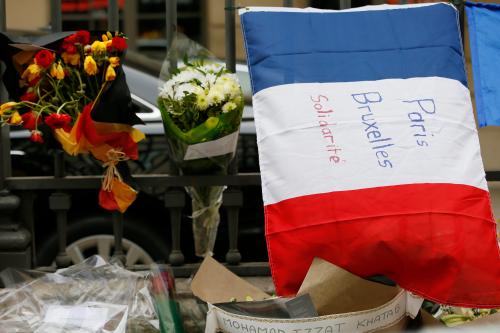Editors’ Note: We need to do better with the long-term instruments of counterterrorism, write Raymond Odierno and Michael O’Hanlon. That includes efforts within our own societies to promote social cohesion. This article originally appeared on USA Today.
In the aftermath of the Brussels tragedy, many good ideas are being floated to improve defenses against terrorists who are poised to strike. Belgium needs more resources for police work, including staking out suspects. Europe needs terrorist watch lists that are better automated and integrated. Police forces and national intelligence agencies need to work together more effectively, readjusting the point at which traditional police work ends and counterterrorism raids begin. We need to use technology such as closed-circuit TV, as well as simpler but time-tested methods like bomb-smelling dogs, more effectively in unhardened public places like subway stops and the external lobbies of airports.
The above are immediate and short-term measures. They are crucial. They are also insufficient. We need to continue to go after Islamic State’s finances, too, leading a worldwide effort to restrict its sources of revenue and ability to store and move funds around. Beyond these actions, we need to do better with the long-term instruments of counterterrorism. These include the use of social media and other counter-messaging against the so-called caliphate. But they also include efforts within our own societies and especially those in Europe to promote social cohesion. Within many countries the inability to develop programs encouraging assimilation of immigrants, and of the home-born disaffected, has led to substantial pockets of disenfranchised citizens, a large majority being Muslim.
At least on issues concerning Muslim-majority communities, the United States can help point the way. We are fortunate, largely to the credit of our nation’s Muslims who join our society in full and pursue the American dream, to have relatively few problems with Islamist extremism. Of course, there are exceptions, but on the whole, Muslim-American communities are our single greatest domestic allies in the struggle against extremism at home. They help provide information on would-be terrorists in their midst; they do not typically shelter, aid or condone the thinking of such extremists. Most of all, acting as loyal citizens, they provide role models and hopeful visions to their young, reducing the odds that the 20-somethings who seem to wind up the main culprits in most attacks abroad will feel the same urge within the United States. Because our own terror watch lists have gotten better since 9/11, and because of the hard work of border and immigration agencies, we are also often able to limit the movements of suspected terrorists to the United States from abroad.
None of this is to sound complacent. More than 70 individuals were arrested on American soil last year on suspicion of interest in supporting Islamic State or otherwise conducting extremist activity, and we suffered the San Bernardino tragedy.
Beyond matters of culture and assimilation, specific programs here contribute as well. In Montgomery County, Maryland, a coalition of faith leaders, school officials and law enforcement officers collaborate to try to identify and help would-be radicals before they turn to dangerous ways. In Ohio, fire departments try to reach into difficult neighborhoods and recruit workers. They recognize that their role in society can be less polarizing to some disaffected than would, say, certain types of police outreach, but that by extending the presence of the government into places where it is not always welcome, they can tamp down the temptations of some to turn to violence.
Many places in Britain are doing the same thing. Britain is a sort of bridge to Europe on this issue, like on many others—not having the apparent problems of say Molenbeek, the enclave in Brussels from which recent attackers have originated, but also having more concentrations of recent immigrants from the Middle East than does the United States. Aware of this situation, British authorities also try to extend the state’s connections with shaky neighborhoods in ways that seek to engender trust in the state and better community rapport. Sometimes this can rely on police, who in the United Kingdom are usually unarmed. However, at other times, less traditional instruments, or less potentially imposing symbols of state authority, can be better. Again, fire departments come to mind, as do work programs that foster a sense of community involvement and cohesion (while also providing a paycheck). Sometimes armies can help, depending on their roles and reputations in given societies. Any of these can improve the government’s image in key neighborhoods, while also helping create the kinds of communications between community leaders and authorities that produce intelligence leads when things start to go off the tracks.
U.S. presidential candidates are not talking much about these kinds of issues. But efforts to build social cohesion are not at odds with what some of them are advocating in response to Brussels. Greater police presence in jurisdictions like Molenbeek, intelligence surges and reforms, and also stronger actions against Islamic State in the Middle East and beyond are needed, to be sure. But such measures are not, in themselves, adequate.
Building social cohesion is difficult, of course, and often the strides forward are slow to come and hard to measure. It usually must happen at the city level. It is usually manpower-intensive work. It is always painstaking. Sometimes, of course, it simply fails. But without a reinvigorated emphasis on building social cohesion, in which cities and other jurisdictions learn from each other and share best practices to tie their communities more strongly together, we will not succeed in this crucial challenge of our times.
The Brookings Institution is committed to quality, independence, and impact.
We are supported by a diverse array of funders. In line with our values and policies, each Brookings publication represents the sole views of its author(s).










Commentary
Assimilation is counterterrorism
April 19, 2016